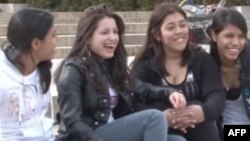“I’m Peruvian-Chinese on my dad’s side.”
“My father is Portuguese.”
The number of young Americans with mixed race and ethnicity is rising real fast in the United States. Many are going to college, helping to bridge racial and ethnic divides on campuses nationwide.
“On my mom’s side, I’m Irish, German, French, Cherokee, and Shawnee.”
“My mother is Haitian and African-American.”
Statistics on race and ethnicity are used by government agencies to assess discrimination against minority groups. There are four major classifications of race in the United States – White, Black, Asian, and American Indian.
These classifications are mostly based on skin color. Most sociologists say this way of classifying people is not science, but they say, it is obsolete.
“I think the idea that race has this kind of historical precedent; that it’s related to skin color and the kind of genes that you have and all of this sort of thing is kind of an old fashioned idea.”
“There’s very little biological difference between the four groups.” Sims says determining ethnicity is just as problematic, but generally, it’s related to country of origin, ancestry, and shared language. Hispanic, for instance, is an ethnicity, not a race.
“Hispanic is attached to people whose origins can be traced to countries where there was Spanish conquest, so they are Spanish-speaking countries.” “So you can be a Hispanic and be a race.
So you can be a Hispanic White. You can be a Hispanic Black. You can be a Hispanic Asian. So it’s complicated.” There’s been a steep rapid rise in the number of multi-racial, multi-ethnic young people now living in the United States. Many of these kids are going to college. The opportunity for higher education was not there for many of their parents.
“Encounters with people of different race do tend to change stereotypes that people have.” “. . . Cause a lot of times, for students coming to college for the first time, it’s the first time we’ve really been placed in such a diverse and different environment.”
Rita’s heritage is Chinese.
She was born and raised in the United States. Areeb and Muneer are also students born and raised in America. “I identify myself first as a Muslim. Then I identify myself from where I was born and raised and where I originally come from. So I guess you could say I’m Muslim American Bengali.”
Rita, Areeb and Muneer say discrimination still exists , even among fellow students, but it’s more subtle and many times, even unintentional.
“For example, they might ask if I own a 7-11 or a taxi or something along these lines.” “Most of the time, people assume that I’m usually Pakistani or Indian, but I’m actually Sri Lankan.”
Rita says another question loaded with cultural cluelessness is when she’s asked if she’s Chinese or American. “I’m both of these and I don’t think I necessarily have to pick and I think that’s a lot of the experiences with people of color, right?
You’re always trying to strive toward, I think, being American, when really, how I’ve made sense of my identity is that I’m both and that’s okay.” And it’s okay with a rapidly growing segment of the U.S. population.
“The three-year-olds in the United States – one of the youngest groups in the United States – now have fewer Whites than other racial and ethnic minorities. Of course, as those three-year-olds get to be four-year-olds and the people that follow them continue to age, we’re going from the bottom up, from the young up to the old, we’re going to become much more global and much more racially and ethnically diverse. “
“Am I Chinese or am I American? But really, I’m both of these.”




